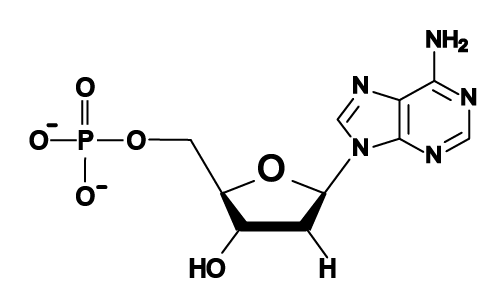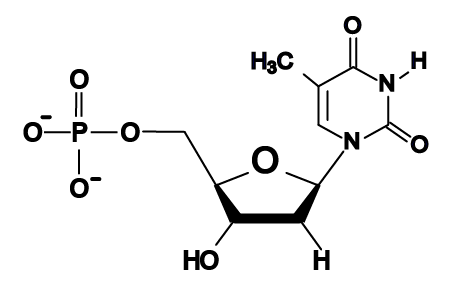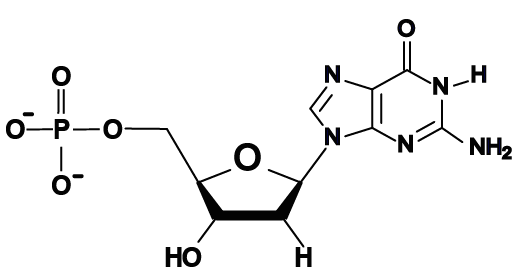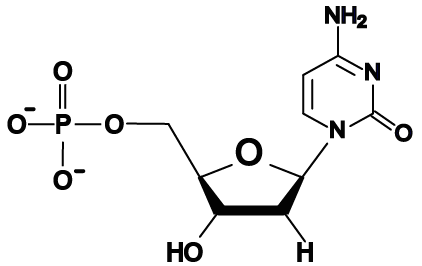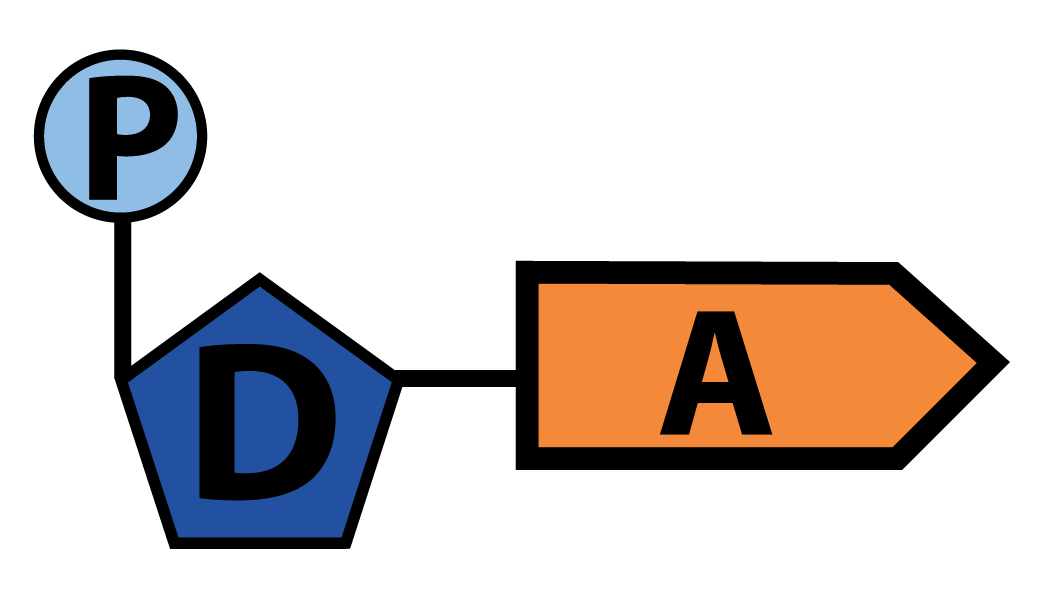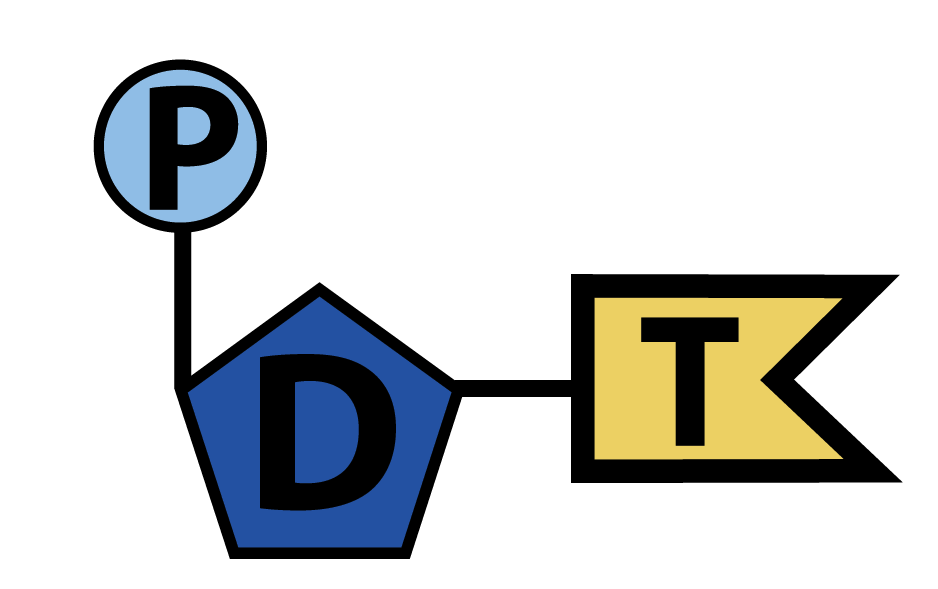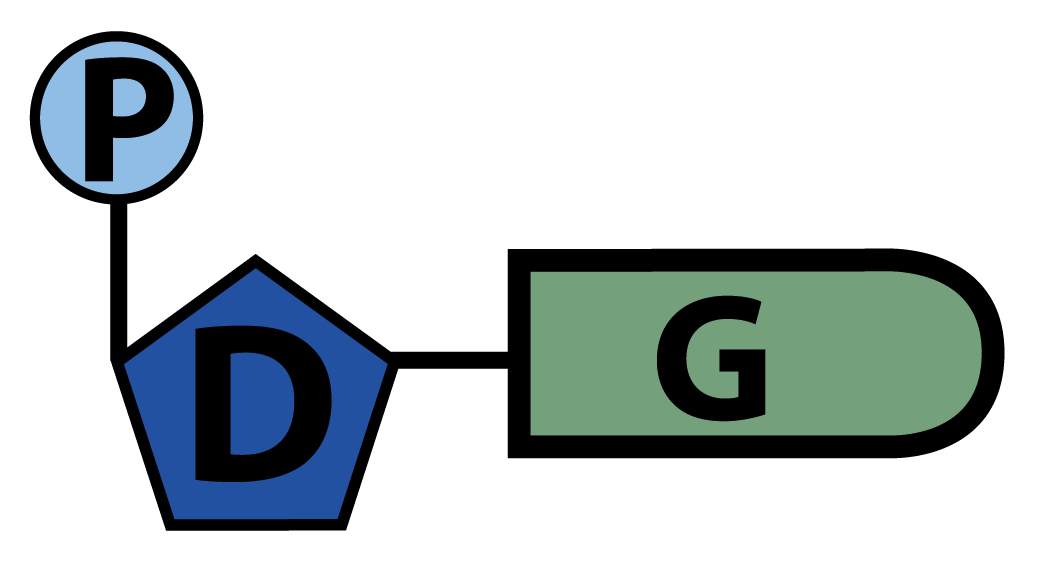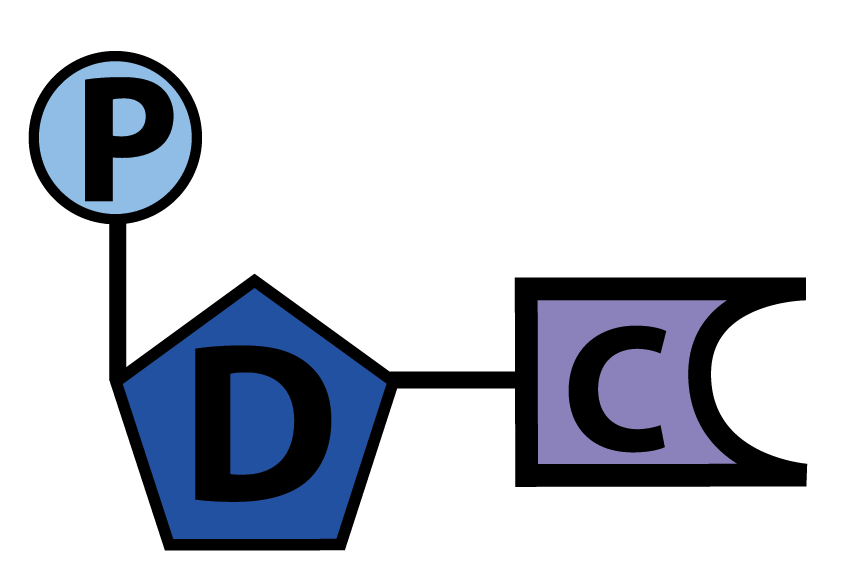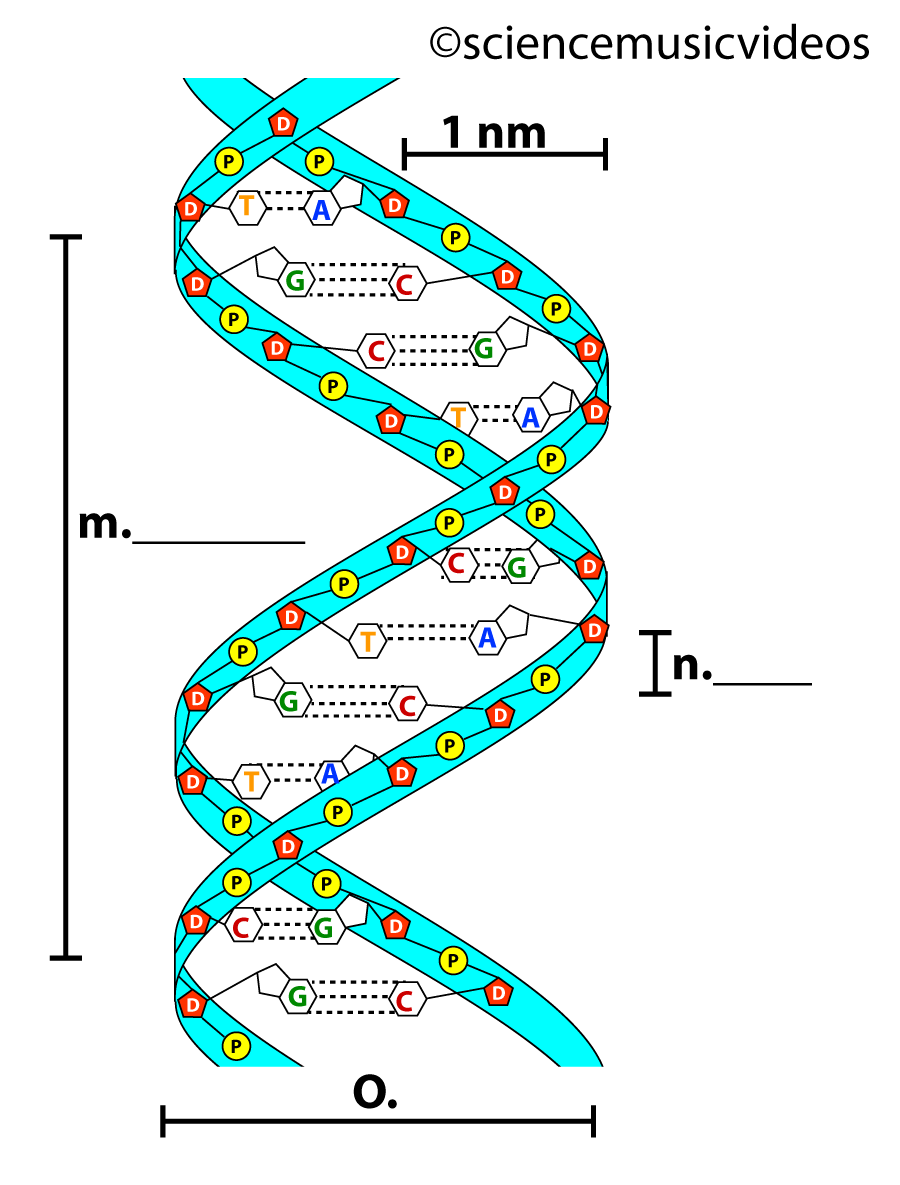Looking for a student learning guide? It’s linked in the main menu for your course. Use the “Courses” menu above.
1. Introduction
In the last tutorial, we saw how DNA is
- the molecule of heredity
- able to control the cell through sending RNA messages to the cytoplasm, where those messages get converted into protein.
Now, let’s see how DNA’s structure makes that possible.
2. Nucleotides are the monomers of DNA
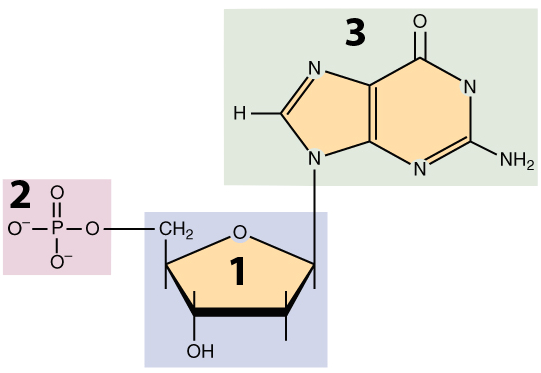
DNA is a nucleic acid. Nucleic acids, along with other macromolecules like proteins and carbohydrates, are polymers. The monomers of nucleic acids are nucleotides.
There are two key nucleic acids: DNA and RNA.
A DNA nucleotide is shown on the left (RNA nucleotides are slightly different). Even though this DNA nucleotide is a monomer, it can be further broken down into three parts.
- A 5-carbon sugar called deoxyribose (part 1). To
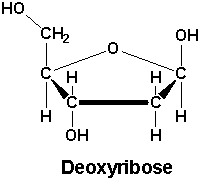 remember that it’s a sugar, just focus on its pentagonal shape. If the 5-carbon sugar designation is confusing, just look to the right. There, you can see deoxyribose with all of its carbons, oxygens, and hydrogens drawn in.
remember that it’s a sugar, just focus on its pentagonal shape. If the 5-carbon sugar designation is confusing, just look to the right. There, you can see deoxyribose with all of its carbons, oxygens, and hydrogens drawn in. - A phosphate group (part 2). Just look for the phosphorus atom in the middle, and you can find the phosphate group.
- A nitrogenous base (part 3). These bases, as you can tell by their name, have several nitrogen atoms, which together with carbon, oxygen, and hydrogen form one or two rings. In some courses, you might have to distinguish between the bases with two rings (purine bases) and those with one ring (pyrimidine bases). I’ve always remembered the difference by thinking “two syllables, two rings” for purines.
The four DNA nucleotides |
|
| Purines (bases with two nitrogen rings) | Pyrimidines (bases with one nitrogen ring) |
|
|
|
|
|
|
Now that we’ve seen the structural formula for each nucleotide, we can switch to a simpler representation. In what’s below, the circle with “P” stands for the phosphate group; the pentagon with “D” stands for deoxyribose; and the various shapes with letters “A,” “G,” “C,” and “T” for adenine, guanine, cytosine, and thymine, respectively.
Four DNA nucleotides |
|
|
|
|
|
|
|
3. Checking Understanding: Nucleotides
[qwiz random = “true” qrecord_id=”sciencemusicvideosMeister1961-Nucleotides_Checking Understanding (M13)”]
[h]Quiz: The Monomers of DNA
[i]
[q]The monomers of DNA are deoxyribo-[hangman]
[c]bnVjbGVvdGlkZXM=
[q]In this diagram, the deoxyribose sugar is at
[textentry single_char=”true”]
[c]MQ ==[Qq]
[f]WWVzLiBUaGUgZGVveHlyaWJvc2Ugc3VnYXIgaXMgYXQgMQ==[Qq]
[c]Kg==[Qq]
[f]Tm8uIExvb2sgZm9yIHRoZSBwYXJ0IHRoYXQgaGFzIGEgcGVudGFnb25hbCAoNS1zaWRlZCkgc2hhcGUu[Qq]
[q]In this diagram, the phosphate is at
[textentry single_char=”true”]
[c]Mg ==[Qq]
[f]WWVzLiBUaGUgcGhvc3BoYXRlwqBpcyBhdMKgMi4=[Qq]
[c]Kg==[Qq]
[f]Tm8uIExvb2sgZm9yIHRoZSBwYXJ0IHRoYXQgaGFzIGEgcGhvc3Bob3J1cyBhdG9tIGluIHRoZSBtaWRkbGUu[Qq]
[q]In this diagram, the nitrogenous base is at
[textentry single_char=”true”]
[c]Mw ==[Qq]
[f]WWVzLiBUaGXCoG5pdHJvZ2Vub3VzIGJhc2UgaXMgYXQgMw==[Qq]
[c]Kg==[Qq]
[f]Tm8uIExvb2sgZm9yIHRoZSBwYXJ0IHRoYXQgaGFzIGEgbml0cm9nZW4gYXRvbcKgaW4gaXQuIEFsc28sIHRoZSBOSA==Mg==IHBhcnQgbWFrZXMgaXQgYSBiYXNlLg==[Qq]
[q]Part 3 is a [hangman] base. Part 2 is a [hangman] group.
[c]bml0cm9nZW5vdXM=[Qq]
[c]cGhvc3BoYXRl[Qq]
[q labels = “top”]
[l]sugar
[fx] No, that’s not correct. Please try again.
[f*] Excellent!
[l]phosphate
[fx] No. Please try again.
[f*] Excellent!
[l]nitrogenous base
[fx] No. Please try again.
[f*] Great!
[q labels = “top”]
[l]sugar
[fx] No, that’s not correct. Please try again.
[f*] Good!
[l]phosphate
[fx] No, that’s not correct. Please try again.
[f*] Great!
[l]nitrogenous base
[fx] No, that’s not correct. Please try again.
[f*] Good!
[/qwiz]
4. Sugar-phosphate bonds form the backbone of a DNA strand.
DNA is composed of two intertwined strands of nucleotides. Let’s look at how each strand forms.
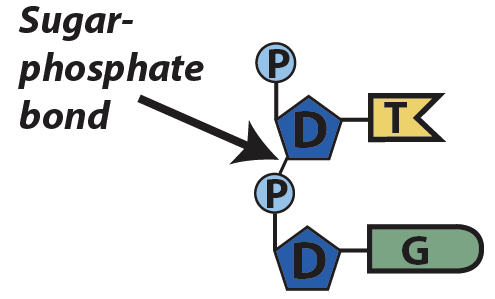 1. The nucleotides connect through sugar-phosphate bonds: a covalent bond between the phosphate group of one nucleotide and the deoxyribose of the next nucleotide.
1. The nucleotides connect through sugar-phosphate bonds: a covalent bond between the phosphate group of one nucleotide and the deoxyribose of the next nucleotide.
2. By connecting one nucleotide to the next, a cell (or a chemist) can create a single strand of any length. The diagram below shows ten nucleotides chained together. In your chromosomes, tens or hundreds of millions of nucleotides are chained together(Wikipedia).

3. The sequence of nucleotides can be in any order. Whereas the strand above runs G-T-C-A-G-T-C-A-G-T, any sequence is possible. In fact, in a chain of nucleotides that’s 10 nucleotides long, you could make 410 possible combinations, which amounts to 1,048,576 distinct sequences. The flexibility of this system gives DNA the power to be the language of life.
4. The sequence of bases enables DNA to specify the order of amino acids in proteins, giving DNA the power to determine a cell’s (and an organism’s) genetic traits. The chain of deoxyribose sugars and phosphates is known as the sugar-phosphate backbone. The function of the sugar-phosphate backbone is completely structural (whereas the function of the bases is to store and provide information).
5. The two strands of DNA are held together by hydrogen bonds between complementary nitrogenous bases
To understand DNA’s structure as a double-stranded molecule, we need to take another look at the nucleotide monomers that make up DNA.
5.a. DNA’s structure is based on the fact that each nucleotide has a shape that complements one (and only one) other nucleotide.
Let’s make sure we understand the terms complement and complementary before proceeding.
- As a verb, to complement means “to complete, to fit, or to go together with.” When I’m dressing well, my shirt complements my pants.
- As an adjective, complementary means “fitting together,” as in complementary colors.
To use a biological example, think about how enzymes complement their substrates. The reason why enzymes are specific is because of this complementarity. Or how the beak of a hummingbird complements the tubular shape of the flowers that the hummingbird pollinates and gets nectar from.
5b. DNA’s base-pairing rules: Adenine and Thymine are complementary; Guanine and Cytosine are complementary
Complementarity (the state of being complementary) among DNA bases is based on both size and shape. Additionally, though many diagrams don’t represent this, the nucleotide pairs are only complementary when the nucleotides are oriented upside down relative to one another.
Adenine and Thymine |
Guanine and Cytosine |
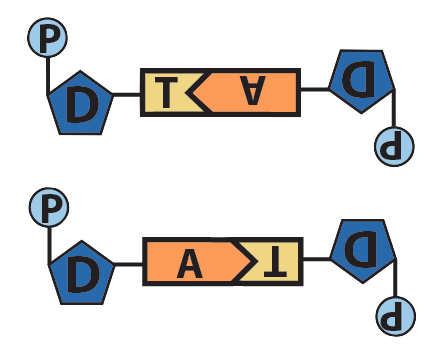 |
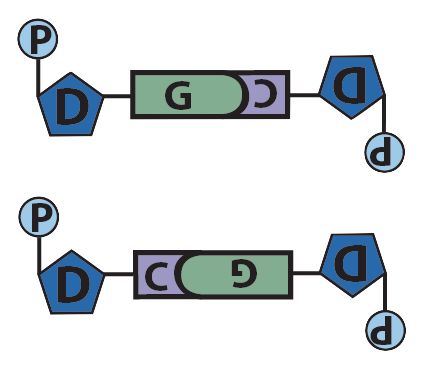 |
Note that each pairing consists of a purine (where the nitrogenous base has two nitrogen rings) paired with a pyrimidine (where the nitrogenous base has one nitrogen ring). As a result, the width of DNA is constant: 2 nanometers for the entire length of the molecules.
Here’s a flattened-out (non-spiral) depiction of DNA that shows its double-stranded structure:

5c. Hydrogen bonding
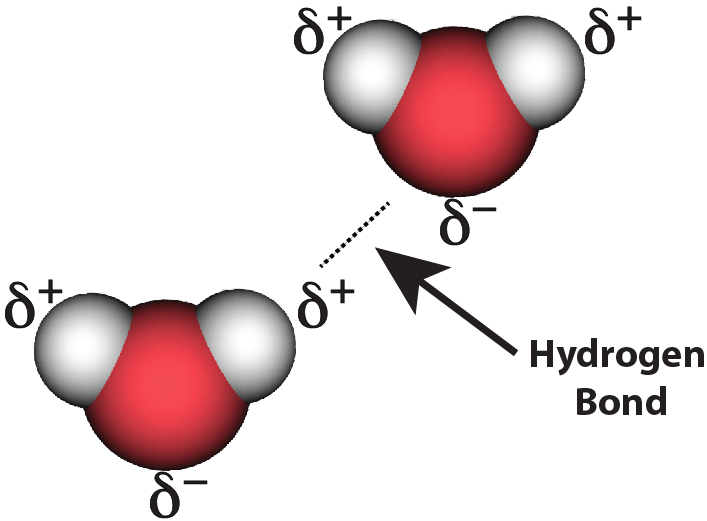
The paired nitrogenous bases don’t only fit together: they also hold onto each other. The bond that connects adenine to thymine or cytosine to guanine is a hydrogen bond.
Hydrogen bonds are often between molecules. In DNA, the hydrogen bonds are within the molecule. In the nitrogenous bases, exposed hydrogen atoms have partial positive charges. Exposed nitrogen or oxygen atoms have partial negative charges. As you can see below, hydrogen bonds form between oxygen and hydrogen, or nitrogen and hydrogen.
| The dotted lines between complementary bases indicate hydrogen bonds | |
| Guanine-Cytosine | Adenine-Thymine |
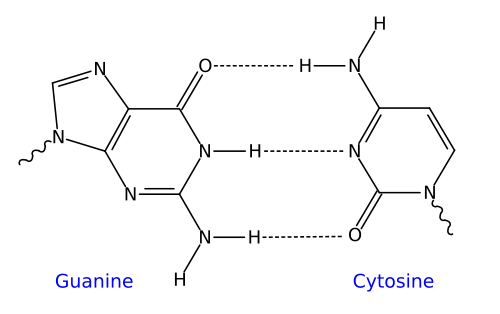 |
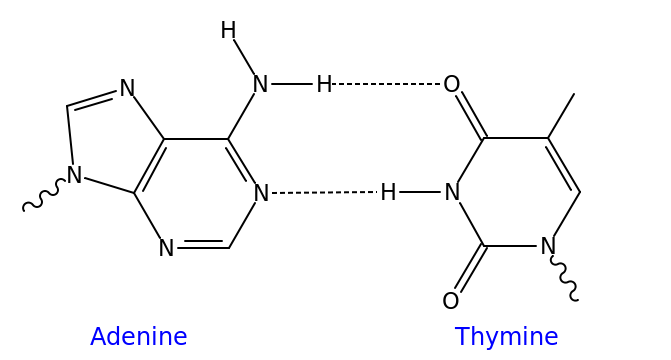 |
These hydrogen bonds play a key role in both DNA’s structure and function. Structurally, they hold the two strands together. Functionally, they make the molecule easy to replicate. These hydrogen bonds can be easily broken by enzymes. With the two strands separated, each strand can serve as a template for the synthesis of a new strand. Replication is a topic we’ll take on in the next tutorial.
6. Base Pair, Hydrogen Bond Practice
[qwiz style=”width: 648px; border: 2px solid black; ” qrecord_id=”sciencemusicvideosMeister1961-Hydrogen Bond Practice”]
[h]Base Pair, Hydrogen Bond Practice
[q labels = “top”]
| matching nucleotide |
___ |
___ |
___ |
___ |
___ |
___ |
___ |
___ |
___ |
| 1st nucleotide |
A |
T |
A |
G |
C |
C |
G |
T |
A |
[
[fx] No, that’s not correct. Please try again.
[f*] Great!
[
[fx] No, that’s not correct. Please try again.
[f*] Correct!
[
[fx] No, that’s not correct. Please try again.
[f*] Excellent!
[
[fx] No, that’s not correct. Please try again.
[f*] Great!
[q labels = “top”]
[l]hydrogen bond
[fx] No. Please try again.
[f*] Good!
[l]covalent bond
[fx] No, that’s not correct. Please try again.
[f*] Excellent!
[x]
[restart]
[/qwiz]
7. The Double Helix: Final Points
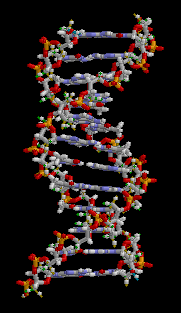 At this point, you should have a good understanding of the structure of DNA. Here are a few final points.
At this point, you should have a good understanding of the structure of DNA. Here are a few final points.
1. DNA is called a double helix because of its shape. A helix is like a corkscrew. DNA is like two, intertwined corkscrews. Hence, a double helix.
2. The two strands of the double helix are anti-parallel to one another. What that means is that the two strands will match up through complementary shape and hydrogen bonding only if each strand, (along with its nucleotides) is oriented upside down relative to the other.
3. You already know that DNA is an acronym for deoxyribonucleic acid.
- The deoxyribo- part refers to the sugar, deoxyribose, that’s a key part of DNA’s structure.
- The nucleic part refers to the fact that DNA is found in the nucleus of eukaryotic cells.
- The acid part refers to DNA’s chemistry: DNA is acidic.
4. The Nobel Prize for the discovery of DNA’s structure went to James Watson, Francis Crick, and Maurice Wilkins, who received their prize in 1962. A fourth contributor to their efforts was Rosalind Franklin, who died in 1958 (and thus could not share in the prize). Franklin’s work was essential in helping Watson and Crick understand the geometry of the double helix, enabling them to create an accurate model. These key dimensions are as follows:
- The width of the double helix is two nanometers (two billionths of a meter). This is represented by the letter “o” in the diagram to the right.
- The distance between two adjacent nucleotides is 0.34 nanometer, represented by “n” at the right.
- It takes 10 nucleotides in a row for the helix to make one complete turn (which you can also think of as the wavelength of the helix). One turn, in other words, is 3.4 nanometers long, a distance represented by “m” in the diagram at the right.
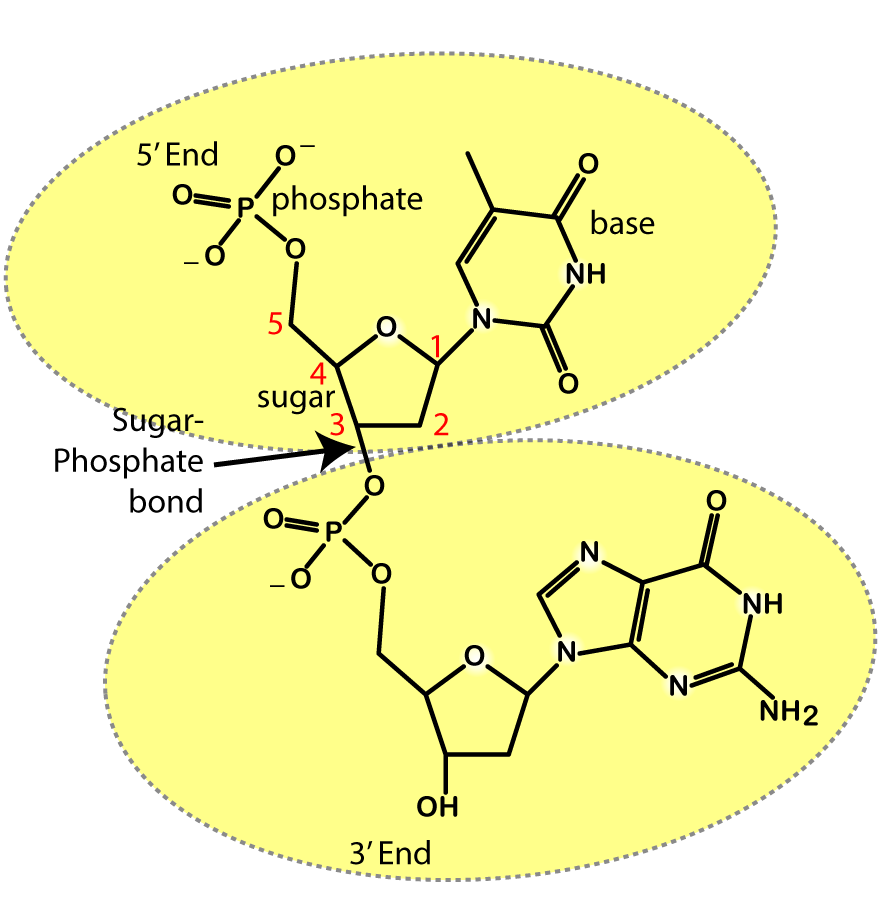 5. DNA is the substrate for many enzymatic reactions. During replication and transcription, for example, enzymes ride along an exposed strand of DNA and synthesize new DNA (during replication) or RNA (during transcription) by adding new nucleotides to the growing daughter strand. In both cases, the enzymes can only add new nucleotides in one direction: the 3′ end.
5. DNA is the substrate for many enzymatic reactions. During replication and transcription, for example, enzymes ride along an exposed strand of DNA and synthesize new DNA (during replication) or RNA (during transcription) by adding new nucleotides to the growing daughter strand. In both cases, the enzymes can only add new nucleotides in one direction: the 3′ end.
What does that mean? Take a look at the structural formula of the two DNA nucleotides that are connected by a sugar-phosphate bond to your left. A convention used by biochemists is to number the carbons in a sugar. Take a good look at the upper nucleotide, and find the # 1 carbon in the sugar deoxyribose. The # 1 carbon is the one that binds to the nitrogenous base. Now find the # 5 carbon: that’s the one that binds to a phosphate group. The # 3 carbon is the one that forms a sugar-phosphate bond with the next nucleotide.
The key thing to remember here is that during the synthesis of DNA or RNA, enzymes move in a 5′ to 3′ direction, always adding new nucleotides at the 3′ end.
8. Quiz: DNA Structure
Note: You can expect to see questions not only from this tutorial but from the previous one, too. Also, I’m going to quiz you on diagrams of DNA that you haven’t yet seen. Your ability to transfer what you know to these new diagrams will help you consolidate your learning.
[qwiz style=”border:3px solid black; ” random = “true” qrecord_id=”sciencemusicvideosMeister1961-DNA Structure (M13)”][h] Quiz: DNA Structure
[i] Here’s how the quiz works:
- Each question is multiple choice or fill-in-the-blanks, but the entire quiz is like a series of flashcards.
- If you get the question right, it comes off the deck.
- If you get the question wrong, it goes to the bottom of the deck, so you can try it again.
[q]The monomers of nucleic acids are [hangman].
[c]bnVjbGVvdGlkZXM=[Qq]
[q]In DNA, cytosine always bonds with [hangman].
[c]Z3VhbmluZQ==[Qq]
[q]In a DNA nucleotide, the sugar is [hangman].
[c]ZGVveHlyaWJvc2U=[Qq]
[q]A common name to describe DNA’s shape is double [hangman].
[c]aGVsaXg=[Qq]
[q]In DNA, guanine always bonds with [hangman].
[c]Y3l0b3NpbmU=[Qq]
[q]Adenine is [hangman] to thymine.
[c]Y29tcGxlbWVudGFyeQ==[Qq]
[q]The nitrogenous bases with one ring are [hangman]. The nitrogenous bases with two rings are [hangman].
[c]cHlyaW1pZGluZXM=[Qq]
[c]cHVyaW5lcw==[Qq]
[q]In DNA, thymine always bonds with [hangman].
[c]YWRlbmluZQ==[Qq]
[q]The bonds connecting complementary base pairs are [hangman] bonds.
[c]aHlkcm9nZW4=[Qq]
[q]In DNA, the orientation of the two complementary strands is anti-[hangman].
[c]cGFyYWxsZWw=[Qq]
[q]In DNA, adenine always bonds with [hangman].
[c]dGh5bWluZQ==[Qq]
[q]The central dogma of molecular genetics is DNA makes [hangman] makes protein.
[c]Uk5B[Qq]
[f]VGhlIGNlbnRyYWwgZG9nbWEgb2YgbW9sZWN1bGFyIGdlbmV0aWNzIGlzIEROQSBtYWtlcyA=Uk5BIG1ha2VzIHByb3RlaW4u[Qq]
[q]DNA stores genetic ____________.
[hangman]
[c]aW5mb3JtYXRpb24=[Qq]
[f]WWVzLiBETkEgc3RvcmVzIGdlbmV0aWPCoA==aW5mb3JtYXRpb24=Lg==[Qq]
[q]The molecule that brings DNA information from the nucleus to the cytoplasm is [hangman].
[c]Uk5B
Cg==[Qq]
[q]The photosynthesizing organelle outside of the nucleus with its own DNA is the [hangman].
[c]Y2hsb3JvcGxhc3Q=
Cg==[Qq]
[q]In eukaryotic cells, the DNA in the nucleus is organized into [hangman].
[c]Y2hyb21vc29tZXM=[Qq]
[q]A unit of heredity is a [hangman].
[c]Z2VuZQ==[Qq]
[q] In the diagram of a DNA molecule below, which number is pointing to a phosphate group?
[c]IDE=[Qq]
[c]IDI=[Qq]
[c]wq Az[Qq]
[c]wqA0[Qq]
[c]wqA1[Qq]
[c]wqA2[Qq]
[c]wqA3[Qq]
[c]wqA4[Qq]
[c]wqA5[Qq]
[f]Tm8uIE51bWJlciAxIGluZGljYXRlcyB0aGUgc3VnYXItcGhvc3BoYXRlIGJhY2tib25lLg==[Qq]
[f]Tm8uIE51bWJlciAyIGluZGljYXRlcyBhIHN1Z2FyLXBob3NwaGF0ZSBib25kLg==[Qq]
[f]WWVzLiBOdW1iZXIgMyBpbmRpY2F0ZXMgYSBwaG9zcGhhdGUgZ3JvdXAu[Qq]
[f]Tm8uIE51bWJlciA0IGluZGljYXRlcyBkZW94eXJpYm9zZS4=
[f]Tm8uIE51bWJlciA1IGluZGljYXRlcyB0aGUgbml0cm9nZW5vdXPCoGJhc2VzIA==YWRlbmluZQ==Lg==[Qq]
[f]Tm8uIE51bWJlciA2IGluZGljYXRlcyB0aGUgbml0cm9nZW5vdXMgYmFzZXMgdGh5bWluZQ==Lg==[Qq]
[f]Tm8uIE51bWJlciA3IGluZGljYXRlcyBoeWRyb2dlbiBib25kcy4=[Qq]
[f]Tm8uIE51bWJlciA4IGluZGljYXRlcyB0aGUgbml0cm9nZW5vdXMgYmFzZSA=Y3l0b3NpbmU=Lg==
[f]Tm8uIE51bWJlciA5IGluZGljYXRlcyB0aGUgbml0cm9nZW5vdXMgYmFzZSA=Z3VhbmluZQ==Lg==
Cg==[Qq]
[q labels = “top”]
[l]deoxyribose
[fx] No, that’s not correct. Please try again.
[f*] Good!
[l]hydrogen bonds
[fx] No, that’s not correct. Please try again.
[f*] Excellent!
[l]nitrogenous base
[fx] No. Please try again.
[f*] Great!
[l]nucleotide
[fx] No. Please try again.
[f*] Correct!
[l]phosphate group
[fx] No. Please try again.
[f*] Good!
[l]sugar-phosphate backbone
[fx] No. Please try again.
[f*] Great!
[l]sugar-phosphate bond
[fx] No, that’s not correct. Please try again.
[f*] Good!
[q labels = “top”]
[l]phosphate group
[fx] No, that’s not correct. Please try again.
[f*] Excellent!
[l]nitrogenous base
[fx] No, that’s not correct. Please try again.
[f*] Correct!
[l]deoxyribose sugar
[fx] No, that’s not correct. Please try again.
[f*] Excellent!
[q] In the diagram of a DNA molecule below, which number is pointing to the sugar-phosphate backbone?
[c]ID E=[Qq]
[c]IDI=[Qq]
[c]wqAz[Qq]
[c]wqA0[Qq]
[c]wqA1[Qq]
[c]wqA2[Qq]
[c]wqA3[Qq]
[c]wqA4[Qq]
[c]wqA5[Qq]
[f]WWVzLiBOdW1iZXIgMSBpbmRpY2F0ZXMgdGhlIHN1Z2FyLXBob3NwaGF0ZSBiYWNrYm9uZS4=[Qq]
[f]Tm8uIE51bWJlciAyIGluZGljYXRlcyBhIHN1Z2FyLXBob3NwaGF0ZSBib25kLg==[Qq]
[f]Tm8uIE51bWJlciAzIGluZGljYXRlcyBhIHBob3NwaGF0ZSBncm91cC4=[Qq]
[f]Tm8uIE51bWJlciA0IGluZGljYXRlcyBkZW94eXJpYm9zZS4=
[f]Tm8uIE51bWJlciA1IGluZGljYXRlcyB0aGUgbml0cm9nZW5vdXPCoGJhc2VzIA==YWRlbmluZQ==Lg==[Qq]
[f]Tm8uIE51bWJlciA2IGluZGljYXRlcyB0aGUgbml0cm9nZW5vdXMgYmFzZXMgdGh5bWluZQ==Lg==[Qq]
[f]Tm8uIE51bWJlciA3IGluZGljYXRlcyBoeWRyb2dlbiBib25kcy4=[Qq]
[f]Tm8uIE51bWJlciA4IGluZGljYXRlcyB0aGUgbml0cm9nZW5vdXMgYmFzZSA=Y3l0b3NpbmU=Lg==
[f]Tm8uIE51bWJlciA5IGluZGljYXRlcyB0aGUgbml0cm9nZW5vdXMgYmFzZSA=Z3VhbmluZQ==Lg==
Cg==[Qq]
[q labels = “top”]
[l]RNA
[fx] No, that’s not correct. Please try again.
[f*] Great!
[l]translation of RNA to protein
[fx] No, that’s not correct. Please try again.
[f*] Correct!
[l]DNA
[fx] No, that’s not correct. Please try again.
[f*] Excellent!
[l]cell membrane
[fx] No. Please try again.
[f*] Excellent!
[l]cytoplasm
[fx] No, that’s not correct. Please try again.
[f*] Good!
[l]protein
[fx] No, that’s not correct. Please try again.
[f*] Good!
[l]transcription of DNA to RNA
[fx] No, that’s not correct. Please try again.
[f*] Great!
[l]nuclear membrane
[fx] No, that’s not correct. Please try again.
[f*] Excellent!
[q] In the diagram of a DNA molecule below, which number represents hydrogen bonds?
[c]wqAx[Qq]
[c]wqAy[Qq]
[c]wqAz[Qq]
[c]wqA0[Qq]
[c]wqA1[Qq]
[c]wqA2[Qq]
[c]wq A3[Qq]
[c]wqA4[Qq]
[c]wqA5[Qq]
[f]Tm8uIE51bWJlciAxIGluZGljYXRlcyB0aGUgc3VnYXItcGhvc3BoYXRlIGJhY2tib25lLg==[Qq]
[f]Tm8uIE51bWJlciAyIGluZGljYXRlcyBhIHN1Z2FyLXBob3NwaGF0ZSBib25kLg==[Qq]
[f]WWVzLiBOdW1iZXIgMyBpbmRpY2F0ZXMgYSBwaG9zcGhhdGUgZ3JvdXAu[Qq]
[f]Tm8uIE51bWJlciA0IGluZGljYXRlcyBkZW94eXJpYm9zZS4=
[f]Tm8uIE51bWJlciA1IGluZGljYXRlcyB0aGUgbml0cm9nZW5vdXPCoGJhc2VzIA==YWRlbmluZQ==Lg==[Qq]
[f]Tm8uIE51bWJlciA2IGluZGljYXRlcyB0aGUgbml0cm9nZW5vdXMgYmFzZXMgdGh5bWluZQ==Lg==[Qq]
[f]WWVzLiBOdW1iZXIgNyBpbmRpY2F0ZXMgaHlkcm9nZW4gYm9uZHMu[Qq]
[f]Tm8uIE51bWJlciA4IGluZGljYXRlcyB0aGUgbml0cm9nZW5vdXMgYmFzZSA=Y3l0b3NpbmU=Lg==
[f]Tm8uIE51bWJlciA5IGluZGljYXRlcyB0aGUgbml0cm9nZW5vdXMgYmFzZSA=Z3VhbmluZQ==Lg==
Cg==[Qq]
[q]Which letter in the diagram below corresponds to a distance of 2 nanometers?
[textentry single_char=”true”]
[c]IG 8=[Qq]
[f]IFllcy4g4oCcb+KAnSBpc8KgdGhlIHdpZHRoIG9mIEROQSwgd2hpY2ggaXMgdHdvIG5hbm9tZXRlcnMu[Qq]
[c]Kg==[Qq]
[f]Tm8uIElmIHlvdSBsb29rIGF0IHRoZSB0b3AsIHlvdSBjYW4gc2VlIHRoYXQgdGhlIHJhZGl1cyBvZiBETkEgaXMgMSBubS4gSWYgdGhlIHJhZGl1cyBpcyAxLCB0aGVuIHdoYXQmIzgyMTc7cyB0aGUgZGlhbWV0ZXI/[Qq]
[q]Which letter in the diagram below corresponds to a distance of 3.4 nanometers?
[textentry single_char=”true”]
[c]bQ ==[Qq]
[f]IFllcy4g4oCcbeKAnSBpc8KgdGhlIGRpc3RhbmNlIHJlcXVpcmVkIGZvciB0aGUgaGVsaXggdG8gbWFrZSBvbmUgdHVybiwgd2hpY2ggY29ycmVzcG9uZHMgdG8gMTAgc3RhY2tlZCBudWNsZW90aWRlcywgd2hpY2ggY29ycmVzcG9uZHMgdG8gMy40IG5hbm9tZXRlcnM=[Qq]
[c]Kg==[Qq]
[f]Tm8uwqBCdXQgaGVyZSYjODIxNztzIGEgaGludC4gRmluZCAmIzgyMjA7bi4mIzgyMjE7IFRoZSBkaXN0YW5jZSBiZXR3ZWVuIHR3byBhZGphY2VudCBudWNsZW90aWRlcyBpcyAwLjM0IG5hbm9tZXRlcnMuIENvdW50IGhvdyBtYW55IG51Y2xlb3RpZGVzIGl0IHRha2VzIGZvciB0aGUgaGVsaXggdG8gbWFrZSBvbmUgdHVybiwgYW5kIHlvdSYjODIxNztsbCBoYXZlIHlvdXIgYW5zd2VyLg==[Qq]
[q]Which letter in the diagram below corresponds to a distance of 0.34 nanometers?
[textentry single_char=”true”]
[c]bg ==[Qq]
[f]IFllcy4g4oCcbuKAnSBpcyB0aGUgZGlzdGFuY2UgYmV0d2VlbiB0d28gYWRqYWNlbnQgbnVjbGVvdGlkZXMsIHdoaWNoIGlzIDAuMzQgbmFub21ldGVycy4=[Qq]
[c]Kg==[Qq]
[f]Tm8uIEJ1dCBoZXJlJiM4MjE3O3MgYSBoaW50LiBJdCYjODIxNztzIHRoZSBzbWFsbGVzdCBtZWFzdXJlZCBkaW1lbnNpb24gb24gdGhpcyBkaWFncmFtIChhbmQgdGhlIGRpc3RhbmNlIGJldHdlZW4gdHdvIGFkamFjZW50IG51Y2xlb3RpZGVzKS4=
Cg==[Qq]
[q]Which number is the deoxyribose sugar?
[textentry single_char=”true”]
[c]ID E=[Qq]
[f]IFllcy4g4oCcMeKAnSBpc8KgZGVveHlyaWJvc2U=[Qq]
[c]Kg==[Qq]
[f]Tm8uIEhlcmUmIzgyMTc7cyBhIGhpbnQuIERlb3h5cmlib3NlIGlzIGEgZml2ZS1jYXJib24gc3VnYXIuIEl0cyBzdHJ1Y3R1cmFsIGZvcm11bGEgaXMgYSBwZW50YWdvbi4=
Cg==[Qq]
[q]Which number indicates hydrogen bonds?
[textentry single_char=”true”]
[c]wq Az[Qq]
[f]IFllcy4g4oCcM+KAnSByZXByZXNlbnRzIGh5ZHJvZ2VuIGJvbmRzLg==[Qq]
[c]Kg==[Qq]
[f]Tm8uIEhlcmUmIzgyMTc7cyBhIGhpbnQuIEh5ZHJvZ2VuIGJvbmRzIGFyZSBiZXR3ZWVuIHRoZSBiYXNlcyBpbiBjb21wbGVtZW50YXJ5IG51Y2xlb3RpZGVzLg==
Cg==[Qq]
[q]Which number is the sugar-phosphate backbone?
[textentry single_char=”true”]
[c]ID Q=[Qq]
[f]IFllcy4g4oCcNOKAnSBpcyB0aGUgc3VnYXItcGhvc3BoYXRlIGJhY2tib25lLg==[Qq]
[c]Kg==[Qq]
[f]Tm8uIEhlcmUmIzgyMTc7cyBhIGhpbnQuIEEgYmFja2JvbmUgaXMgcHJldHR5IGxvbmcmIzgyMzA7V2hhdCYjODIxNztzIHRoZSBsb25nZXN0IHN0cnVjdHVyZSBvbiB0aGlzIGRpYWdyYW0/
Cg==[Qq]
[q]Which number is an entire nucleotide?
[textentry single_char=”true”]
[c]NQ ==[Qq]
[f]IFllcy4g4oCcNeKAnSBpc8KgYW4gZW50aXJlIG51Y2xlb3RpZGU=[Qq]
[c]Kg==[Qq]
[f]Tm8uIEhlcmUmIzgyMTc7cyBhIGhpbnQuwqBUaGUgbnVjbGVvdGlkZSBoYXMgdGhyZWUgc3VicGFydHM6IGEgc3VnYXIsIGEgcGhvc3BoYXRlIGdyb3VwLCBhbmQgYSBuaXRyb2dlbm91cyBiYXNlLiBXaGVyZSBkbyB5b3Ugc2VlwqBhbGwgdGhyZWUgb2YgdGhlc2UgYXMgb25lIGxhYmVsZWQgcGFydCBvZiB0aGUgZGlhZ3JhbT8=
Cg==[Qq]
[q]Which number indicates a sugar-phosphate bond.
[textentry single_char=”true”]
[c]Nw ==[Qq]
[f]IFllcy4g4oCcN+KAnSByZXByZXNlbnRzIGEgc3VnYXItcGhvc3BoYXRlIGJvbmQu[Qq]
[c]Kg==[Qq]
[f]Tm8uIEhlcmUmIzgyMTc7cyBhIGhpbnQuIExvb2sgZm9yIGEgY292YWxlbnQgYm9uZCBjb25uZWN0aW5nIGEgc3VnYXIgYW5kIGEgcGhvc3BoYXRlIGdyb3VwLg==[Qq]
[x]
If you want to take this quiz again, click the button below
[restart]
[/qwiz]
Next Steps:
- DNA Replication (the next tutorial in this module)
- DNA structure and Replication Menu
- DNA, Fantastic! (music video)


